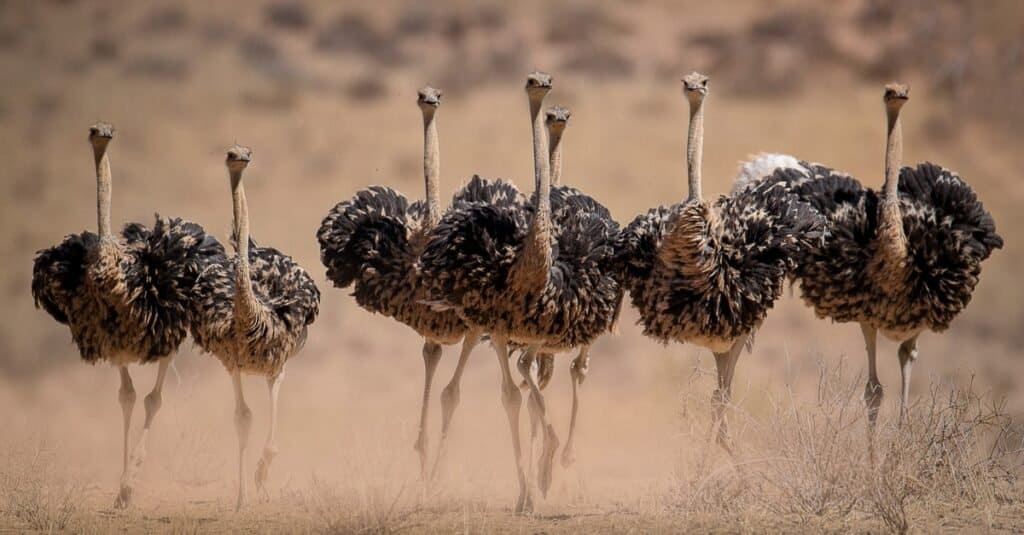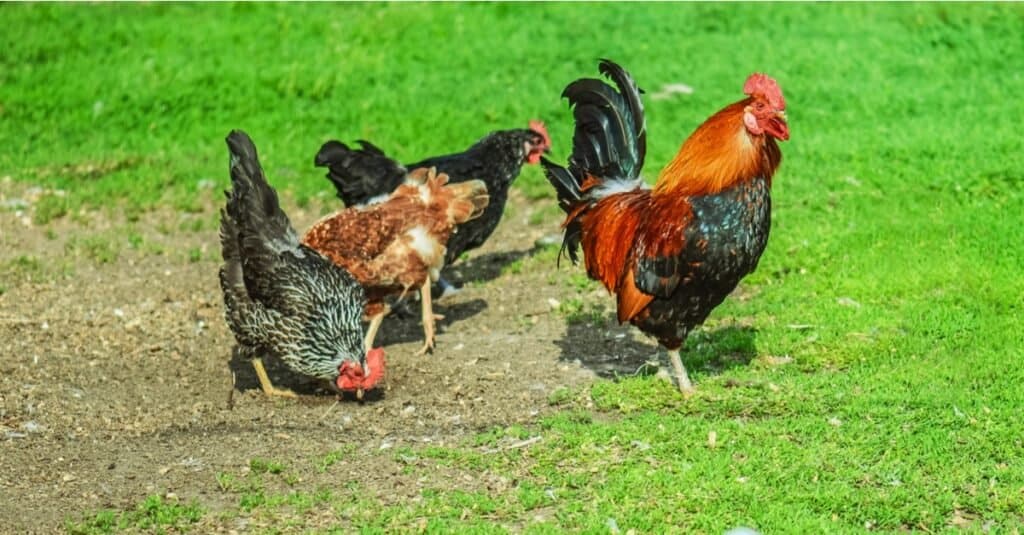Have you ever seen a bird urinate? Probably not. Instead, you’ve probably noticed that birds frequently release white, watery droppings with dark pieces in them. You might have even assumed that this substance is excrement – or poop, in layman’s terms – but you would only be partly correct. Read on to find out whether or not birds pee, how they excrete waste from their bodies, and what it consists of.
Birds Don’t Actually Pee
Let’s cut the suspense. Technically speaking, birds don’t urinate or pee – at least, not in the same way that mammals do. Unlike mammals, birds don’t have bladders with which to store urine. Their anatomy differs in many other significant ways too. By understanding these differences, you can quickly grasp why they don’t technically “go pee.” Instead, they release all of their waste in combined droppings consisting of uric acid, water, and fecal material.
Avian Anatomy: Why Birds Don’t Pee
When mammals like dogs release liquid waste, which is referred to as urine, it’s usually pretty obvious. Mammals have urethras, or tubes, which run from their bladders, and they eject urine from their bladders through their urethras and out their urethral openings. Solid waste, which is known as feces, is eliminated separately.
Birds are different. Unlike mammals, they don’t have urethras, urethral openings, or, in most cases, bladders. Here’s a quick breakdown of avian anatomy as it relates to waste elimination:
The Cloaca
Instead of releasing waste through a urethra and urethral opening, which may be found on the penis in male mammals and near the vagina in female mammals, birds release waste through an organ called a cloaca. Derived from a Latin word meaning “to cleanse,” “sewer” or “drain,” the cloaca is an opening that connects to the reproductive, digestive, and urinary systems. Urine and feces both drain into the cloaca, where they mix together before being expelled.
It’s also worth noting that the cloaca, a narrow tube, also houses the reproductive organs. In reproduction, it acts as an opening through which sperm is transferred from the male to the female.
No Bladder or Urethra
In birds, liquid waste isn’t stored long in the body because birds don’t have bladders. This is by design; after all, a bird with a full bladder would weigh a lot more, making flying difficult. Instead of being stored in a bladder, bird pee is sent straight from the kidneys to the cloaca. The cloaca absorbs much of the liquid waste back into the body; indeed, roughly 98% of the water that’s filtered by avian kidneys is reabsorbed, effectively conserving water and eliminating the need for a bladder.
Since there’s no bladder, there’s also no urethra. As noted above, whatever pee that isn’t absorbed is sent directly to the cloaca.

©bruna-nature/Shutterstock.com
The Avian Digestive System
Birds eliminate waste that consists of urine and feces. Most birds’ digestive systems begin with the mouth. From there, food and liquid travel into the stomach and then into the gizzard. After being partially digested and turned into a substance called chime, it continues into the small intestine and then to the large intestine. However, that term is a bit of a misnomer because a bird’s large intestine is very short and small – not much bigger than the small intestine. The large intestine is also known as the rectum, and the waste passes from there into the cloaca.
The Kidneys
Although they lack bladders and urethras, birds have a pair of kidneys that function much like those of mammals. The kidneys’ primary function is to filter toxins from the blood and then turn it into waste in the form of urine. In cleansing the blood like this, they help to maintain the fragile water-electrolyte balance.
No Penis
The vast majority of male birds don’t have penises. Instead, they use their cloacae to pass sperm to females’ cloacae. However, there are exceptions. Some birds, including ostriches, certain ducks, and “chicken-like” birds, have penis-like organs similar to those of crocodiles.
Nitrogenous Waste and Bird Pee
Like mammals, birds produce metabolic waste products containing nitrogen. Known as nitrogenous wastes, these substances are produced through metabolic processes. Basically, this waste consists of anything the body can’t use. A significant portion of this waste consists of nitrogen; when combined with water, nitrogen creates ammonia, a very toxic substance that must be eliminated quickly and efficiently for proper functioning.
Birds’ metabolic processes extract energy from the consumption of protein molecules. Amino acids inside those protein molecules are broken up to produce energy; the stuff leftover is what turns into ammonia.
In mammals, eliminating ammonia from the body requires copious amounts of water. That’s because it is converted into a compound called urea, which is less toxic and requires less water to expel from the system.
Since birds don’t have bladders, they can’t store enough water to produce urea. Instead, their bodies produce nitrogenous waste, mainly in the form of uric acid, which is the most complex form of such waste. It requires more energy to produce than urea, but very little water is necessary.
Put simply, since birds don’t have bladders, they don’t produce urea or guanine. The uric acid that they produce effectively flushes harmful ammonia byproducts from their bodies. This substance primarily consists of nitrogen but also includes potassium and phosphate, making it an excellent fertilizer. It is highly concentrated and nearly insoluble, so bird “pee” has a thick, white, sticky consistency.
What Does Bird Pee Look Like?
Bird droppings usually consist of a pasty, chalky-white colored portion and darker flecks of material. The pasty, white substance is the closest thing to “pee” that a bird produces. Unlike mammal urine, however, it is hardly a liquid at all.
Although it’s usually white, bird pee may appear a bit yellow if exposed to sunlight or after decomposing for a while.
Avian droppings are highly toxic, and they often contain parasites that can cause serious diseases in mammals and other animals. In particular, bird pee and poop may contain E. coli or salmonella, so it is important not to touch it and to wash your hands if you come into contact with it.
St. Louis Encephalitis is a potentially grave illness which can be caused by bird poop. More precisely, it is caused by house finches, house sparrows, and pidgeons, and can itself cause fevers and headaches. It can also result in comas and even be fatal.
Histoplasmosis is another potentially fatal illness also caused by that unique combo of avian waste. It is caused as a result of inhaling the spores of a fungus found in bird and bat droppings. It may also cause fevers and headaches, and even spread to the lungs and nervous system.

©iStock.com/-101PHOTO-
How Often Do Birds Pee?
Since they don’t have bladders, most birds can’t “hold in” their poop and pee. However, there are exceptions. For example, chickens are capable of “holding it” for periods of time.
Compared to mammals, birds pee very frequently because they process food and liquids rapidly. Smaller birds eliminate waste more frequently than larger ones. Food passes through a bird’s digestive tract in 2.5 to 12 hours. As noted previously, their intestines are also quite short, which speeds things up even more.
Birds don’t have to squat or otherwise do anything to pee. In fact, they often do so right when they are taking off in flight. This allows them to shed excess weight, making them lighter and more aerodynamic. If you’ve ever wondered why birds poop and pee on cars so much, it’s because they often perch upon electrical lines, telephone poles, buildings, and trees that are right near parked vehicles. When they are startled by humans, they quickly evacuate waste as they take to the sky.
Another thing to keep in mind is that, unlike many mammals, birds don’t sweat. Therefore, they don’t eliminate water that way; they lose more hydration through breathing than anything else.
How Do Birds Pee – and How Much?
Birds have very high metabolisms and average body temperatures of between 102 and 112 degrees Fahrenheit, and they must eat nearly constantly while awake to maintain their body temperatures. Since they eliminate uric acid along with feces, they pee very frequently.
Although most birds pee and poop simultaneously, not all do. For example, ostriches – which have bladders, unlike most birds – release liquid urine from their cloacae before defecating solid waste. In fact, there is speculation that some dinosaurs, which are closely related to birds, may have eliminated waste much as ostriches do. Scientists suspect that land-based dinosaurs probably eliminated waste similarly to those hefty, land-based birds.
Is It Good Luck to Be Peed On By a Bird?
You may have heard that it’s good luck when a bird pees on you. Naturally, most people want to avoid being pooped or peed on by birds. However, in Russia, it is said that being peed on by birds means that you’re going to come into money soon. On the other hand, according to old British wives’ tales, rook droppings are meant to be punishments for human transgressions.
Birds Don’t Pee Like Us, But They Still Eliminate Liquid Waste
Although it can’t be said that birds pee like mammals and other animals do, they do eliminate liquid waste and eject it from their bodies. However, it’s mixed together with solid waste or feces and usually expelled from the cloaca as a bird takes off to fly. Bird pee isn’t liquid but more like a pasty, semi-solid substance – and that’s the closest thing to liquid urine that birds produce.
Up Next…
Keep reading these posts for more incredible information about key animal facts.
- Are Birds Animals? Where do birds fall on the scale of living things? Take a look into their biological classifications to find out.
- Are Birds Mammals? They’re warm-blooded. And even though they can fly they’re by no means arthropods. Find out if they are mammals or worthy of their very own classification.
- All About Pidgeons: They’re one of the most popular birds on the globe and are virtually ubiquitous. Here you’ll get to read about the different varieties that exist.
The photo featured at the top of this post is © Chris Hill/Shutterstock.com
Thank you for reading! Have some feedback for us? Contact the AZ Animals editorial team.







